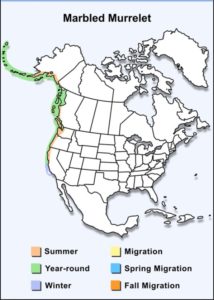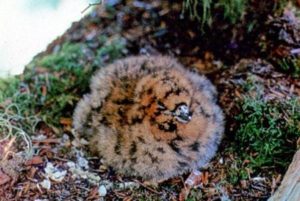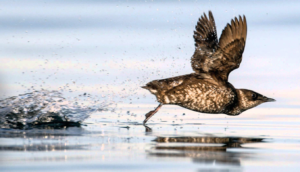Brachyramphus marmoratus
- Threatened – Federal Endangered Species Act (1992)
- Endangered – California Endangered Species Act (1992)
- Endangered – IUCN Red List
Biology & Behavior
The only seabird that nests in old-growth forests — possibly as far south as the coast redwood stands in the Los Padres National Forest — the small and chunky marbled murrelet is a member of the auk family and a close relative to the puffin. Auks are considered a monomorphic species, meaning that males and females are similar in both appearance and size. Marbled murrelets can be distinguished from their relatives based on their slender black bills, pointed wings, white underbellies and the black feathers which cover their crowns, nape, wings and back. A monogamous species, marbled murrelets and other species of auks will form lifelong pairs and return to the same nesting site year after year. Spending most of their time in offshore waters, they often forage in pairs and feed mainly on small fish and crustaceans.
Marbled murrelets will begin breeding at the age of two and nest from mid-spring to early September. Once laid the egg is incubated for a full month before a newborn chick hatches. Like other auks, marbled murrelets breed only once a year and lay a single egg each time. Chicks are cared for and fed by both parents for a period of 40 days until the chick is able to fledge and leave the nest.

Marbled murrelets range as far south as Santa Barbara County in the winter. Range map courtesy National Audubon Society.
Threats
As a member of the auk family, the marbled murrelet is known for its ability to both fly and swim exceptionally well, despite its awkward and clumsy attempts at walking on land. What sets the species apart from the rest of the auk family is that the marbled murrelet is known to nest high in the old-growth of large trees within coastal forests. In fact, it is the only seabird known to breed on land in old-growth forests. This unique nesting characteristic was virtually unknown until a few decades ago when a tree climber found a chick high up in a tree in 1974. As the species relies on old-growth forests for breeding, it has been seriously threatened by logging coastal forests of the Pacific Northwest efforts that occurred in the 19th century and later.
Due to the close association between the loss of old-growth forests and the sharp declines in this species’ populations, the marbled murrelet has become a flagship species for the forest preservation movement. Changes in populations are more detectable within the southern part of its range although very few nests have ultimately been found. Accurate population surveys have been even more challenging to accomplish in Canada and Alaska where harsh terrain and larger populations make changes in population more difficult to detect.
Marbled murrelets primarily nest on the branches of old growth of mature conifers such as western hemlock, Douglas-fir, and coast redwood. As the majority of nests have been found on the limbs of large conifers that exhibit old-growth characteristics of about 150-250 years of age, the biggest threat to marbled murrelet populations has long been attributed to the lost of their nesting habitat due to the logging of old-growth forests.
Food scraps and waste left by recreationists who do not practice leave no trace ethics have been shown to lure in predators such as crows and ravens, which then feed on marbled murrelet chicks and eggs. Oil spills, entanglement in fishing nets, and changes to ocean conditions due to climate change have also been factors contributing to declining populations and loss of habitat.
Conservation
As a result of the many threats facing the species’ populations and habitat, the U.S. Fish and Wildlife Service (USFWS) listed the southern range of marbled murrelet populations in California, Oregon and Washington as “threatened” in 1992. The species has also been listed as “endangered” under the California Endangered Species Act.
The USFWS completed a recovery plan for the marbled murrelet in 1997. Preventing the decline and fragmentation of current nesting sites while conserving potential nesting habitat are listed as important steps in protecting this threatened species. Critical habitat designation was also finalized by the agency in 2016, protecting areas as far south as Santa Cruz County.
Very few surveys have been conducted along California’s central coast to determine the extent to which marbled murrelets migrate to the area. There have been observations along the Big Sur coast and as far south as Point Conception. While our area is part of the species’ winter range, some observations here were made in summer and fall. In fact, a nest was once found in Big Basin Redwoods State Park in Santa Cruz County, indicating that the species was breeding along the central coast. There may be suitable habitat in the coast redwood groves in the Los Padres National Forest in Big Sur, but more studies need to be conducted.









